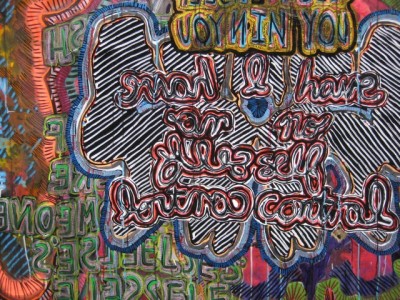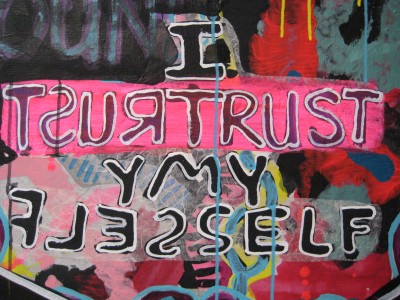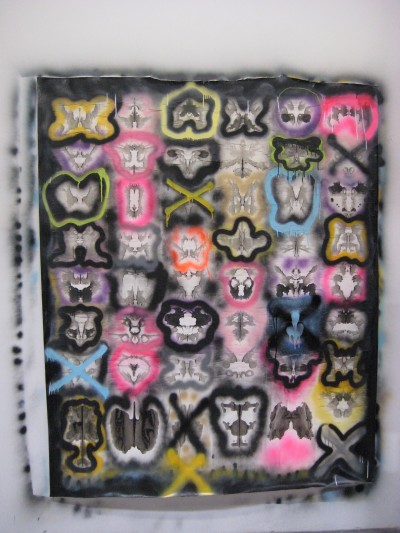Painting Psychology
An Interview With Alexandra Grant
by Stephanie Washburn
Alexandra Grant uses language and networks of words as the basis for her painting, drawing, and sculpture. She has been the subject of shows at the Museum of Contemporary Art (Los Angeles), the Contemporary Museum (Baltimore), and galleries in the U.S. and abroad. She invited me into the studio to talk about a new and developing body of work.
Q. Your last body of work was a series of paintings based on text by the poet Michael Joyce. Do you think of yourself more as a representational or abstract painter?
A. I’m really both. I’m trying to represent a kind of thinking around language. But language is so abstract, and in many ways I’m a completely abstract painter.
Q. The first change I notice in the new work is that you are using a sort of self-help language–phrases like “I found myself” and “I have myself to blame.” Is this your voice? The viewer’s?
A. The words here are a voice that’s everywhere but not really mine specifically. They are the confessional voice you only admit at the shrink or in your own head. The shift to “I”–people take the “I” very seriously–becomes the “I” of the viewer, which I find really fascinating.
Q. On the other hand, they’re such hyperbolic and clichéd phrases, it almost feels like they mean nothing. It makes them funny.
A. I do think there’s a kind of goofiness to these common phrases about the self when they are said out loud. I don’t know if those voices in our heads are really part of who were are or just part of a culture of psychology that is really consumer culture.
Q. This kind of language doesn’t typically happen in the place painting happens. The language seems banal and neurotic and contemporary.
A. And I’m elevating it to the timeless space of painting.
Q. Seems timely. So we can really get a look at it?
A. That’s the idea–it’s everwhere but utterly unseen. I’m trying to make something visible that’s become naturalized–like a secret decoder. This idea of the self seems to be where psychology and consumption work together.
Q. These ideas could have been explored in any number of media. What does painting bring? And specifically choosing to paint the words one on top of the other, in dense textures and color variations, so they become almost impossible to read?
A. The visuality of language, of always being two things at once–sign and signifier–has always been interesting to me as a subject. My work has always had some sort of distancing strategy in it, because it makes you look harder to read or see it. My early work, for example, was written backwards to move you from reading individual words to start perceiving larger patterns. I want to make an art about language and ideas that also engages with materials and the real mess of lived life. I’m interested in work that bridges these schisms between mind and body. I love working through materials to try to prove a concept. In this case, I’ve been inspired by the documentary Century of the Self by Adam Curtis.
Q. And are the new ideas also changing the work formally?
A. Material has always been central to what I do. The subject of my last body of work was the experience of the female body, and so the materiality of the paint, applied almost so thickly many people thought it was yarn, was the right material. Now, working with these voices to explore the self and psychology, collage is the right approach, mirroring the way that the self is constructed. The rorschach is the architectonic form for this new body of work–it’s the perfect vehicle for projecting. In that way, the paintings are interactive. At least in the viewer’s mind.
Q. And, of course, artists always assume their work will be interpreted. But you seem to be setting that up more literally as the subject here.
A. I like that. What I’m enjoying is that I’m having completely different conversations around these new images from the ones I’ve had before. Psychology is usually an assumption in the studio–think of all the interest in artists’ lives as a way of interpreting their work. Making this work I’ve been thinking about Warhol a lot, and I’m starting to get parts of his work that I didn’t before. Looking now at his rorschach paintings, I understand that he was grappling with ideas of projection as much as he was in his Jackie O paintings, how we are constantly projecting upon by looking upon. I want my new work to enter into a conversation about this: how looking at paintings is caught up in how we project ourselves.
Stephanie Washburn is an artist based in Ojai and Los Angeles and a lecturer in the Department of Art and UC Santa Barbara.
*Art by Alexandra Grant.








Send A Letter To the Editors